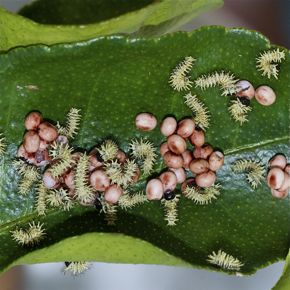Caterpillars are a favourite food with birds LINK 1, LINK 2. However, those of the Atlas moth (Attica atlas) do not appear to be popular. There is a single report in this website where an Oriental Pied Hornbill (Anthracoceros albirostris) caught a large caterpillar LINK.
Yet when I introduced the first (above left) and second instar caterpillars on to the leaves of Singapore rhododendron (Melastoma malabathricum), one of their many food plants, the caterpillars survived the first two days. Then they all disappeared. Something must have taken these small caterpillars. Birds? Wasps?
The absence of documenting can be because the earlier instar caterpillars are small and not that easy to notice and thus photograph. Also, most people are not familiar with these early caterpillars as images are rare. In the internet most images show the large and fat ones, always noticed and photographed after they have defoliated the trees. However, we now have the early instar images with bodies white and traces of orange (above right), later with prominent large orange spots on the anal claspers (below). The development of the caterpillars from eggs to pupa to moth can be viewed HERE and HERE.
The video clip below shows a later stage instar caterpillar munching on the leaves of the starfruit (Averrhoa carambola) that should be attractive to birds.
According to Deml & Dettner (1994), the caterpillars have a potent defensive mechanism to deter birds. They have the ability to either discharge a droplet or spray a defensive secretion to a distance of 20-50 cm when disturbed. This discharge contains certain aromatic substances that deter birds. The discharge is triggered when sufficient pressure is applied to the body, as when a bird pecks at it. However, in my months of “farming” these caterpillars, I failed to encounter this discharge, even when handling the later instar caterpillars (below: left = last instar, right = pupating caterpillar). Maybe I failed to apply the necessary pressure.
The fact that the hornbill mentioned above did pick up a fat caterpillar and presumable ate it up may be due to its long and huge bill, making it immune to the chemical spray. According to nature enthusiast KF Yap, he “believes that something is definitely eating the caterpillars. He came across a batch of caterpillars happily munching away in a tree. He returned a week later to find not a single caterpillar around, not even a trace of the cocoons” LINK. Check also Jeremy Lee‘s involvement with these fascinating insect HERE.
YC Wee
Singapore
September 2012
Reference:
Deml, R. & K. Dettner, 1994. Attacus atlas caterpillars (Lep., Saturniidae) spray an irritant secretions from defensive glands.



![12. 3rd instar 22d cat [wyc] - 6](https://besgroup.org/wp-content/uploads/12.-3rd-instar-22d-cat-wyc-6.jpg)
![13. 30d-cat-ventral [wyc] - 1](https://besgroup.org/wp-content/uploads/13.-30d-cat-ventral-wyc-1.jpg)
![14. ?4th instar 34d cat-colour change [wyc]](https://besgroup.org/wp-content/uploads/14.-4th-instar-34d-cat-colour-change-wyc-.jpg)
![15. 5th instar 49d-cat [wyc] - 05](https://besgroup.org/wp-content/uploads/15.-5th-instar-49d-cat-wyc-05.jpg)
![4. 39d old cat pupating2 [wyc] - 2](https://besgroup.org/wp-content/uploads/4.-39d-old-cat-pupating2-wyc-2.jpg)






